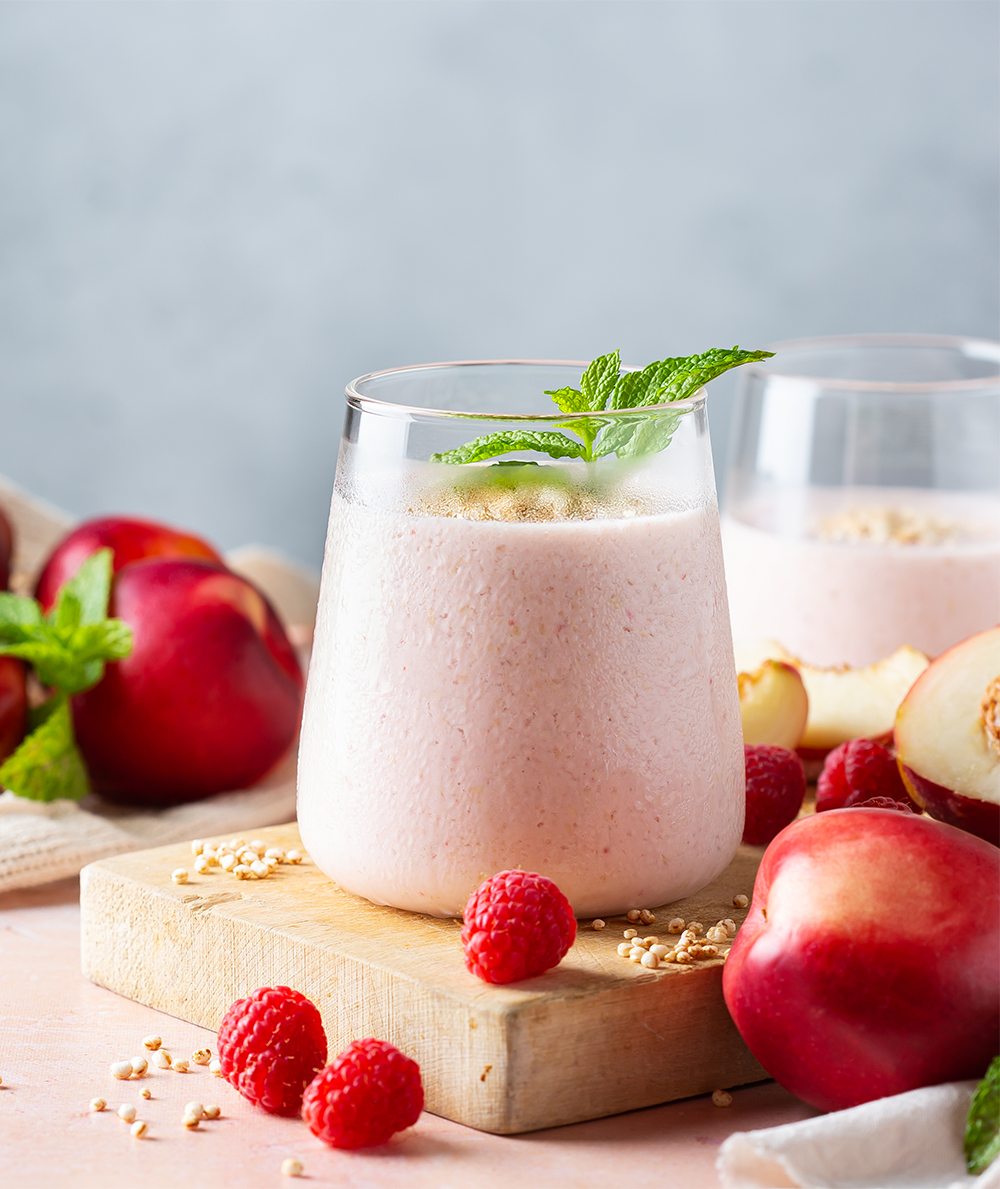Sunday: Welcome to Week 2!

This week we’re focusing on smoothies.
Smoothies are one of our favorite “tricks” to pack in multiple nutrient-dense foods into a single meal or snack.
For many folks, one of the obstacles to eating with more color and variety is the flavor. If you’re not used to certain flavor profiles, it might be hard to force yourself to eat more of those foods. The good news is we can grow to like these flavors through exposure – and smoothies are an easy and yummy way to get there. The blend of flavors (for example, combining bitter greens with tart citrus and sweet berries) can help mask the new flavors we’re not used to.
Another challenge you may also face is getting the sheer volume of recommended colors into your diet – especially if you’re experiencing digestive issues or don’t have a big appetite. Smoothies are especially excellent for those of us with digestive challenges as the pulverized plant fibers may make it easier for your digestive system to handle.
To-Do
1. Read through your Sunday Resources.
This week your resources includes:
- A balanced smoothie formula you can use as a guide when making your own smoothie recipes.
- A 7-Recipe Smoothie E-book - feel free to follow exactly as is, or if you're feeling creative, use it as inspiration.
2. Plan Ahead.
Do your shopping and prep for the week to set yourself up for success.
Sunday (Week 2) Resources
The Balanced Smoothie Formula
Smoothies are an excellent way to experiment with new and diverse flavor profiles but that can be overwhelming if you don’t know where to start.
Never fear! Read on for a Rainbow Challenge coach-approved smoothie formula that you can use to guide your smoothie experimentation, as well as some information about each category and food examples:
FORMULA = PROTEIN + GREENS + FAT + FRUIT (& FIBER)
Protein
Protein is an essential part of building a balanced smoothie. Protein is especially important in the morning in promoting alertness, the release of satiety hormones, and supporting metabolic health, among other health benefits.
Here are some examples of sources:
- 1 serving of greek yogurt
- 1 serving of cottage cheese (trust us on this one! It's packed with protein and makes your smoothie taste like a milkshake)
- 1 serving of your favorite protein powder
- Collagen* powder supplement
- 1 TBSP of hemp seeds (also packed with healthy fats and fiber)
- 1 TBSP of nut butter or nuts (eg. almond, walnuts, cashew)
*Although collagen is a great source of protein, it’s not a complete protein and should be used as a supplement; we suggest using it in combination with nuts and/or seeds for a more well rounded amino acid support.
Greens
Smoothies are an excellent vessel for those daily servings of greens. Greens provide ample amounts of fiber, phytonutrients, and vitamins & minerals, as well as good amounts of water to support hydration.
Some of our favorites are:
- Spinach
- Arugula
- Kale (pro-tip: try baby kale, it's milder and less fibrous)
- Romaine lettuce
- Parsley
- Mint
- Cilantro (great when paired with citrus fruits!)
- Broccoli sprouts (packed with sulforaphane, a potent anti-inflammatory plant compound that supports liver health and detoxification)
Fat
Healthy fats are another critical part of balanced smoothie making. Not only do fats provide high amounts of anti-inflammatories, fat-soluble vitamins, and minerals, but they help keep you full and energized until your next meal.
Some healthy fats that work great in smoothies include:
- Nuts* (eg. walnuts, almond, pistacho, macadamia)
- Nut butter* (eg. peanut, almond, cashew)
- Seeds* (eg. pumpkin (for a healthy dose of zinc!), chia, ground flaxseed, sesame, sunflower)
- 1-2 tsp Olive Oil
- 1-2 tsp MCT Oil
*Nuts & seeds are a great source of all 3 macronutrients: fats, protein, and carbohydrates – in addition to all the vitamins, minerals, antioxidants, and phytonutrients!
Fruit and Fiber
What’s a smoothie without some fruit? We totally agree but it’s important to remember the formula here. Fruit provides color, fiber, and antioxidants but without the other balanced smoothie components (i.e. protein and fat), fruit-only smoothies can cause that all-to familiar energy spike (and crash) that doesn’t set you up for success.
Prioritizing fruit with high fiber content is going to help slow down digestion, offering you a sustained release of energy.
Read below for some ideas:
- Berries (blueberries, raspberries, blackberries, and strawberries)
- Avocado (yes it's a fruit! And makes your smoothie nice and creamy)
- Apples
- Oranges
- Lemons*
- Grapefruit*
- Kiwi
- Pears
- Banana
- Fresh coconut (this also gets in your serving of healthy fats)
- Seasonal fruit
As we enter the summer months, think about incorporating seasonal fruits into your smoothies. If you live in the US, here are some coach-approved options:
- Apricots
- Peaches
- Plums
- Nectarines
- Cherries
- Strawberries
- Blueberries
- Mango
- Watermelon
- Avocado
*Most of us instinctively add more sweet to offset bitter greens, but tart citrus like lemon and grapefruit are a great addition to a smoothie with bitter greens like kale. Sour/tart helps to balance the flavor – so give this a try especially if you find the greens too strong and you’re interested in training your palate to like more bitter veggies.
Smoothie Recipes
Hopefully this formula will help you start to experiment and get creative making smoothies – in the meanwhile, clear here for a mini eBook with some smoothie recipes to get you started.
Suggested Supplements
While I highly suggest you set a foundation with whole food, I (Lara here!) get a lot of questions about supplement recommendations.
One of the other benefits of smoothies is it allows us to “sneak” in supplements to balance our nutritional needs. I’ll include my Fullscript Protocol “Smoothie Boosters” and link HERE if you’re curious
